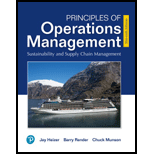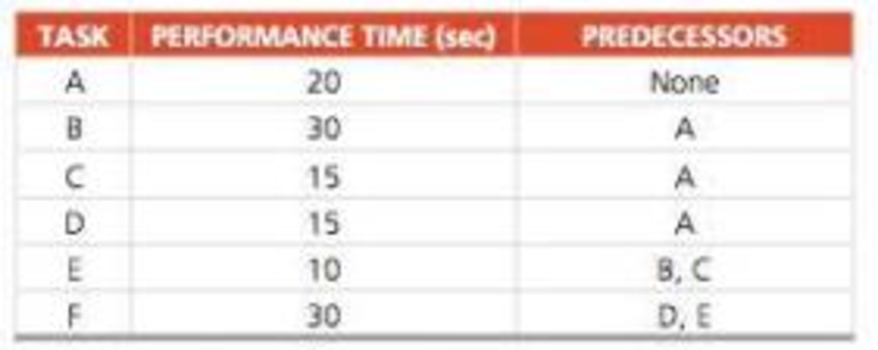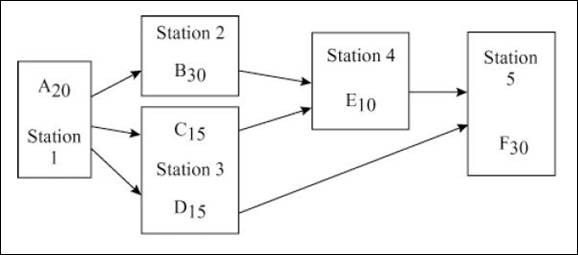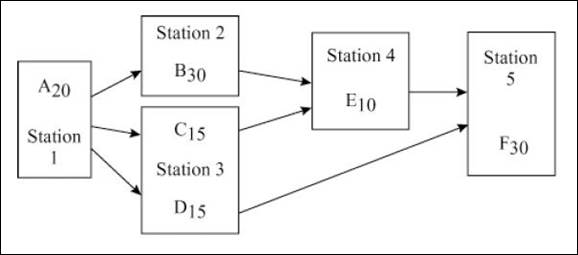
Concept explainers
The Action Toy Company has decided to manufacture a new train set the production of which is broken into six steps. The demand for the train is 4,800 units per 40-hour workweek:

a) Draw a precedence diagram of this operation.
b) Given the demand, what is the cycle time for this operation?
c) What is the theoretical minimum number of workstations?
d) Assign tasks to workstations.
e) How much total idle time a present each cycle?
f) What is the efficiency of the assembly line with five stations? With six stations?
a)
To draw: The precedence diagram.
Answer to Problem 15P

Explanation of Solution
Given information:
| Task | Time (seconds) | Immediate predecessors |
| A | 20 | - |
| B | 30 | A |
| C | 15 | A |
| D | 15 | A |
| E | 10 | B, C |
| F | 30 | D, E |
| Total | 120 |
- Weekly demand is 4,800 units / 40 hours workweek.
Precedence diagram:

b)
To determine: The cycle time.
Introduction:
Cycle time:
Cycle time is the total time taken to complete an unit of work from the beginning of the process to the end of the process.
Answer to Problem 15P
The cycle time is 30 seconds / unit.
Explanation of Solution
Given information:
| Task | Time (seconds) | Immediate predecessors |
| A | 20 | - |
| B | 30 | A |
| C | 15 | A |
| D | 15 | A |
| E | 10 | B, C |
| F | 30 | D, E |
| Total | 120 |
- Weekly demand is 4,800 units / 40 hours workweek.
Formula to calculate cycle time:
Calculation of cycle time:
The cycle time is 30 seconds / unit.
c)
To determine: The theoretical minimum number of workstations.
Answer to Problem 15P
The theoretical minimum number of workstations is 4 workstations.
Explanation of Solution
Given information:
| Task | Time (seconds) | Immediate predecessors |
| A | 20 | - |
| B | 30 | A |
| C | 15 | A |
| D | 15 | A |
| E | 10 | B, C |
| F | 30 | D, E |
| Total | 120 |
- Weekly demand is 4,800 units / 40 hours workweek.
- Average daily demand is 50 chairs.
Formula to calculate theoretical minimum number of workstations:
Calculation of theoretical minimum number of workstations:
The theoretical minimum number of workstations is 4 workstations.
d)
To assign: The different tasks to different workstations.
Explanation of Solution
Assignment of different tasks to different workstations:
| Workstation | Elligible tasks | Selected tasks | Task time (seconds) | Available cycle time (seconds) | Remarks |
| 1 | 30 | ||||
| A | A | 20 | 10 | Task A is the only elligible ask | |
| 10 (Idle Time) | No other elligible task is available | ||||
| 2 | 30 | ||||
| B, C, D | B | 30 | 0 | Task B has the highest task time | |
| 3 | 30 | ||||
| C, D | C | 15 | 15 | Task C is assigned | |
| D | D | 15 | 0 | Task D is assigned | |
| 4 | 30 | ||||
| E | E | 10 | 20 | Task E is the only elligible task available | |
| 20 (Idle time) | The available cycle time is less than the task time | ||||
| 5 | F | F | 30 | 0 | Task F is assigned |
| Workstation | Task assigned | Idle time |
| 1 | A | 10 |
| 2 | B | 0 |
| 3 | C, D | 0 |
| 4 | E | 20 |
| 5 | F | 0 |
| Total | 30 |
e)
To determine: The idle time per cycle.
Answer to Problem 15P
The idle time is 30 seconds / cycle.
Explanation of Solution
Given information:
| Task | Time (seconds) | Immediate predecessors |
| A | 20 | - |
| B | 30 | A |
| C | 15 | A |
| D | 15 | A |
| E | 10 | B, C |
| F | 30 | D, E |
| Total | 120 |
- Weekly demand is 4,800 units / 40 hours workweek.
- Average daily demand is 50 chairs.
Calculation of idle time per cycle:
The idle time is 30 seconds / cycle.
f)
To determine: The efficiency.
Introduction:
Efficiency:
Efficiency is the measure of what is actually produced as opposed to what can be theoretically produced with the same amount of resources.
Answer to Problem 15P
The efficiency with five and six workstations is 80% and 66.6% respectively.
Explanation of Solution
Given information:
| Task | Time (seconds) | Immediate predecessors |
| A | 20 | - |
| B | 30 | A |
| C | 15 | A |
| D | 15 | A |
| E | 10 | B, C |
| F | 30 | D, E |
| Total | 120 |
- Weekly demand is 4,800 units / 40 hours workweek.
- Average daily demand is 50 chairs.
Formula to calculate efficiency:
Calculation of efficiency for five workstations:
Calculation of efficiency for six workstations:
The efficiency with five and six workstations is 80% and 66.6% respectively.
Want to see more full solutions like this?
Chapter 9 Solutions
EBK PRINCIPLES OF OPERATIONS MANAGEMENT
- The Action Toy Company has decided to manufacture a new train set, the production of which is broken into six steps. The demand for the train is 4,500 units per 40-hour workweek: (See image) The theoretical minimum number of workstations is ???Were you able to assign all the tasks to the theoretical minimum number of workstations? Yes or No ??arrow_forwardA manager wants to assign tasks to workstations as efficiently as possible and achieve an hourlyoutput of four units. The department uses a working time of 56 minutes per hour. Assign the tasksshown in the accompanying precedence diagram (times are in minutes) to workstations using thefollowing rules:a. In order of most following tasks. Tiebreaker: greatest positional weight.b. In order of greatest positional weight. Tiebreaker: most following tasks.c. What is the efficiency?arrow_forwardA manufacturing company is designing an assembly lineto produce its main product. Th e line should be able to produce60 units per hour. Th e following data in Table 10-16 give thenecessary information. (a) Which task is the bottleneck?(b) Draw a precedence diagram for the above information.(c) Compute the cycle time with a desired output of 60 unitsper hourarrow_forward
- Stanford Rosenberg Computing wants to establish an assembly line for producing a new product, the Personal Digital Assistant (PDA). The tasks, task times, and immediate predecessors for the tasks are as follows: Task Time (sec) Immediate Predecessor A 11 − B 14 A C 8 A D 4 B, C E 20 D Rosenberg's goal is to produce 180 PDAs per hour. a) The cycle time for the production of a PDA = 20 seconds (round your response to two decimal places). Part 3 b) The theoretical minimum number of workstations that Rosenberg can achieve in this assembly line=3(round your response up to the next whole number). c) For one to assign the tasks to the actual workstations and be able to use the "theoretical minimum" number, the activity assignment should be: Workstation # Tasks Assigned to Workstation 1 A ▼…arrow_forwardA small assembly line for the assembly of power steering pumps needs to be balanced. Precedence diagram is shown below. The cycle time is determined to be 1.7 minutes. How would the line be balanced by choosing the assignable task having the longest task time first? Fill in the table below. If your answer is zero, enter "0". Round your answers to one decimal place. Station Tasks Total Time Idle Time 1 B,A,C,D 2 E,F 3 G,H,I Total What is the assembly-line efficiency? Round your answer to one decimal place. %arrow_forwardA company is setting up an assembly line to produce 90 units per hour. The table below identifies the work elements, times, and immediate predecessors. Work Element Time (Sec.) Immediate Predecessor(s) A 25 - B 18 A C 20 A D 5 B, C E 12 C F 8 E G 16 D, F H 12 G What cycle time is required to satisfy the required output? What is the theoretical minimum number of stations?arrow_forward
- Stanford Rosenberg Computing wants to establish an assembly line for producing a new product, the Personal Digital Assistant (PDA). The tasks, task times, and immediate predecessors for the tasks are as follows: Task Time (sec) Immediate Predecessor A 11 − B 15 A C 7 A D 4 B, C E 20 D Rosenberg's goal is to produce 175 PDAs per hour. a) The cycle time for the production of a PDA = nothing seconds (round your response to two decimal places). B) what's the minimum number of workstations in the assembly line? C) Can the minimum actually be reached when workstations are assigned?arrow_forwardA company is setting up an assembly line to produce 192 units per 8-hour shift. The following table iden-tifies the work elements, times, and immediate predecessors: a. What is the desired cycle time (in seconds)?b. What is the theoretical minimum number of stations?c. Use trial and error to work out a solution, and show your solution on a precedence diagram.d. What are the efficiency and balance delay of the solution found?arrow_forwardGiven the following task, times, and sequence, develop a balanced line capable of operating with a I 0-minute cycle time at Dave Visser's company. a) Draw the precedence diagram.b) Assign tasks to the minimum feasible number of workstations according to the greatest time remaining (ranked positional weight) decision rule.c) What is the efficiency of the process?arrow_forward
- The Action Toy Company has decided to manufacture a new train set, the production of which is broken into six steps. The demand for the train is 4,800 units per 40-hourworkweek: c) What is the theoretical minimum number of workstations? d) Assign tasks to workstations. e) How much total idle time is present each cycle?arrow_forwardStanford Rosenberg Computing wants to establish anassembly line for producing a new product, the Personal DigitalAssistant (PDA). The tasks, task times, and immediate predecessorsfor the tasks are as follows: Rosenberg's goal is to produce 180 PDAs per hour.a) What is the cycle time?b) What is the theoretical minimum for the number of workstations that Rosenberg can achieve in this assembly line?c) Can the theoretical minimum actually be reached when workstations are assigned?arrow_forwardDaily demand of a product is 240 units and the assembly line operates 8-hour per day. The task times and precedence relationship are given below. Task Task time (sec) Immediate predecessor A 60 B 80 A C 20 A D 50 A E 90 B,C F 30 C,D G 30 E,F H 60 G a. What is the assignment task-workstation assignment obtained using ranked positional weight heuristic? b. What is the cycle time achievable? c. What is the efficiency of the line?arrow_forward
 Practical Management ScienceOperations ManagementISBN:9781337406659Author:WINSTON, Wayne L.Publisher:Cengage,
Practical Management ScienceOperations ManagementISBN:9781337406659Author:WINSTON, Wayne L.Publisher:Cengage, Operations ManagementOperations ManagementISBN:9781259667473Author:William J StevensonPublisher:McGraw-Hill Education
Operations ManagementOperations ManagementISBN:9781259667473Author:William J StevensonPublisher:McGraw-Hill Education Operations and Supply Chain Management (Mcgraw-hi...Operations ManagementISBN:9781259666100Author:F. Robert Jacobs, Richard B ChasePublisher:McGraw-Hill Education
Operations and Supply Chain Management (Mcgraw-hi...Operations ManagementISBN:9781259666100Author:F. Robert Jacobs, Richard B ChasePublisher:McGraw-Hill Education
 Purchasing and Supply Chain ManagementOperations ManagementISBN:9781285869681Author:Robert M. Monczka, Robert B. Handfield, Larry C. Giunipero, James L. PattersonPublisher:Cengage Learning
Purchasing and Supply Chain ManagementOperations ManagementISBN:9781285869681Author:Robert M. Monczka, Robert B. Handfield, Larry C. Giunipero, James L. PattersonPublisher:Cengage Learning Production and Operations Analysis, Seventh Editi...Operations ManagementISBN:9781478623069Author:Steven Nahmias, Tava Lennon OlsenPublisher:Waveland Press, Inc.
Production and Operations Analysis, Seventh Editi...Operations ManagementISBN:9781478623069Author:Steven Nahmias, Tava Lennon OlsenPublisher:Waveland Press, Inc.





